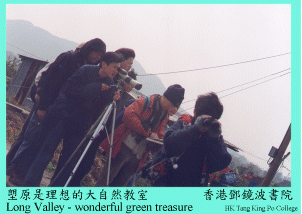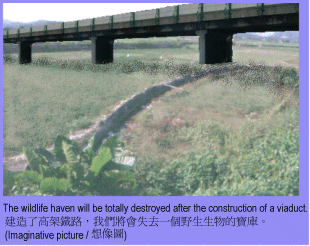|
|

KCRC and Government must co-operate
KCRC's proposed route cuts right across Long Valley, fragmenting the floodplain and seriously degrading the last example of this habitat and farming practice in the territory. Despite plans to elevate the spur line on a viaduct above the marsh, this threatens the 210+ species of birds recorded here. The potential loss of Long Valley in its current state has raised protest in all sections of Hong Kong society and from international conservation bodies and eco-tourism operators who regularly visit Hong Kong. "The ecological significance of Long Valley is recognised by all parties, including KCRC and Secretary for Planning and Lands, Gordon Siu," commented Mike Kilburn, Conservation Officer, Hong Kong Bird Watching Society. "We believe that with close co-operation between KCRC and relevant government departments the spur line and west Rail Phase II extension can be re-routed and Long Valley can be preserved as an example of environmentally sensitive sustainable development in Hong Kong." "We recommend the zoning of Long Valley as a Conservation Area, creating a freshwater, inland Mai Po, that would be actively managed by government to preserve both the birds and their habitat - the traditional wet agriculture vegetable fields," said Karen Woo, Assistant Conservation Officer, WWFHK. "In addition, Long Valley could serve as an educational resource and eco-tourism site, providing open space around the Kwu Tung North "Green City".
"HKBWS is not opposed to the development of railways in Hong Kong," added Mr. Kilburn. "However we do not believe KCRC has tried hard enough to avoid building across Long Valley, despite recognising the ecological value of the site. Since government has already agreed to the realignment of the Fanling Bypass (a highway) outside the boundaries of Long Valley, why not realign the railway too, making efficient use of land through a shared transport corridor?"
At present the Railways Ordinance allows KCRC's plans for routing of new lines to be gazetted prior to obtaining approval under the EIA Ordinance and without due planning process under the Town Planning Ordinance. Since railways constitute just one element of properly planned development, this is a clear contradiction of common-sense practice and contrary to legislative intent. "The KCRC routing, and refusal to propose less damaging alternatives directly contravenes the spirit of the Chief Executive's 1999 Policy Address which encouraged a more environmentally sensitive approach to development," noted Dr. Ng Cho Nam, President of The Conservancy Association. "The damage to Long Valley also flies in the face of the efforts of the Hong Kong Tourism Authority to encourage eco-tourism, for which Long Valley is a recognised site. The long-term vision of a Government in putting in place such a reserve (transcending sectional, commercial and departmental agendas) would win international applause for the Hong Kong SAR." HKBWS, WWFHK and CA believe it is possible to live up to Mr. Tung's vision of a cleaner and greener Hong Kong by preserving Long Valley's biological and cultural diversity as a cultivated freshwater floodplain for future generations. This would ensure that birds such as the Painted Snipe and eleven other globally and regionally threatened species are not lost to Hong Kong. In addition the traditional and environmentally friendly floodplain agriculture, which is a part of the agricultural heritage of the New Territories, does not disappear.
For further contact:
Hong Kong Bird Watching Society
World Wide Fund For Nature Hong Kong
The Conservancy Association
Copyright 1999, Hong Kong Bird Watching Society.
|
 The cry to preserve Long Valley was echoed by
The cry to preserve Long Valley was echoed by  KCRC claims that restrictions in engineering convenience, land resumption, financing, and other areas make it impossible to re-route the spur line away from this "preferred engineering option". Furthermore, additional plans for Phase II of West Rail show a second line cutting across the flood plain, further segmenting and damaging the ecological integrity of Long Valley. HKBWS firmly believes that by examining the alternatives, more efficient and cost-effective routings could be developed which leave Long Valley as it is today. Further examples of
KCRC claims that restrictions in engineering convenience, land resumption, financing, and other areas make it impossible to re-route the spur line away from this "preferred engineering option". Furthermore, additional plans for Phase II of West Rail show a second line cutting across the flood plain, further segmenting and damaging the ecological integrity of Long Valley. HKBWS firmly believes that by examining the alternatives, more efficient and cost-effective routings could be developed which leave Long Valley as it is today. Further examples of